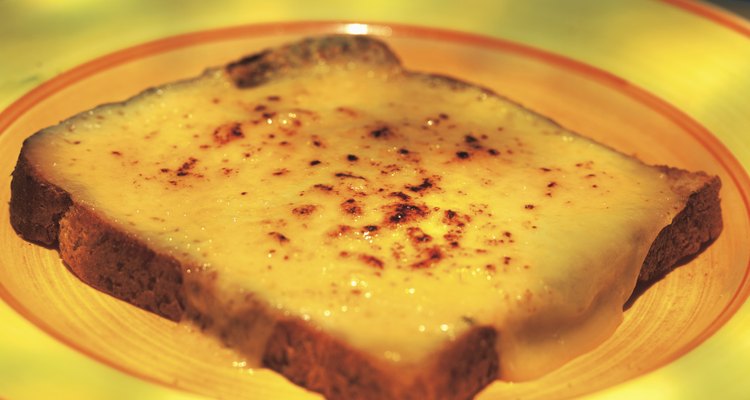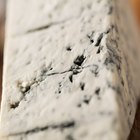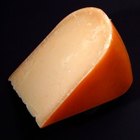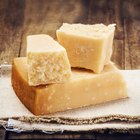
Stockbyte/Stockbyte/Getty Images
Some foodies joke that nearly every dish can be improved by covering it with melted cheese. But not all cheeses melt in the same way. Finding just the right cheese for your dish can make the difference between delight and possible disaster. You may have discovered that some cheeses melt poorly or not at all. Several factors govern how or whether a particular cheese will melt.
Curds, Whey and Melting
In the cheese-making process, milk proteins and fats are separated from milk liquids and sugars. During coagulation, protein structures change to trap fats, giving cheese its distinctive creamy-chewy texture. The separated solids are usually called curds, while the strained-off mixture of water, sugar and lactic acid particles, is called whey. Some whey particles remain in the cheese curds. The amount of whey remaining in a finished cheese determines its bound calcium content.
Cheeses with a high calcium content, like cottage cheese, halloumi, paneer, farmer cheese or queso blanco, may soften and blend with other ingredients when heated, but they become grainy rather than buttery or stretchy. The predictably low-melt texture of ricotta cheese comes from its being manufactured from whey. Many cheeses that melt poorly or not at all have a high whey and calcium content.
Acidity and Melting
Cheese curds are formed by adding a coagulating agent, which determines the acid content, or pH level, of the cheese. Coagulators are commonly a lactic acid source, like buttermilk, or a lower-acid source, like rennet, a product derived from a calf's stomach. The pH of cheeses ranges from 4.5 for feta cheese to 7.44 for Camembert. Low pH makes protein fibers brittle. Cheeses with a low pH, like feta, are crumbly and don't melt well. Cheeses with a high pH -- low acid cheeses -- on the other hand, display other melting problems, becoming soupy or gloppy without actually melting. Without stabilization, traditional Camembert and brie are low-melters. High-melting cheeses generally have pH levels in the 5.0 to 5.5 range.
Moisture
The moisture remaining in a cheese after whey is washed away has an impact on the cheese's melting ability and melting point. Moisture, along with salt content, determine how tightly protein fibers are bound to each other, and therefore the way they soften and stretch when they're heated. Cheeses with a high level of moisture, among them jack, baby Swiss, cheddar and Cheshire, have lower melting points than drier cheeses. Cheddar, for example, melts at around 150 degrees Fahrenheit. Some cheeses, like Parmesan, are drier and harder than cheddar, even when newly finished. The melting point for Parmesan is approximately 180 F.
Salt
How much salt is used in the curing process also affects its melting ability. Feta is a low-melt cheese partly because of its acid coagulation source but also because it is cured in a salt brine. A high salt level binds protein fibers tightly and reduces melting capacity. Salt content adds one more reason to why a dry, aged Parmesan cheese is a low-melt cheese and may contribute to the poor melting performance of blue cheeses like Gorgonzola.
Related Articles

What Good Bacteria Is in Cheese?

What Makes a Cheese Mild, Medium or ...

Aged Cheeses That Do Not Melt
List of High Temperature Cheeses

How to Store Cheese

The Best Melting Cheeses

Can You Melt Ricotta?

What Is Animal Rennet?

MSG and Parmesan Cheese

Why Do Cheeses Brown When Placed Under ...

Why Does Milk Curdle When Baking a ...

Cheeses Similar to Feta

How to Tell if Mozzarella Is Bad

How to Liquefy Cheese

Can I Make Baked Macaroni & Cheese With ...

What Type of Microorganism Is Used to ...

Can You Make Homemade Mozzarella Cheese ...

Types of Cheese Used in Pizza

How Long Can You Refrigerate Nacho ...

Seasoning Ricotta Cheese for Lasagna
References
Writer Bio
Janet Beal has written for various websites, covering a variety of topics, including gardening, home, child development and cultural issues. Her work has appeared on early childhood education and consumer education websites. She has a Bachelor of Arts in English from Harvard University and a Master of Science in early childhood education from the College of New Rochelle.
Photo Credits
Stockbyte/Stockbyte/Getty Images